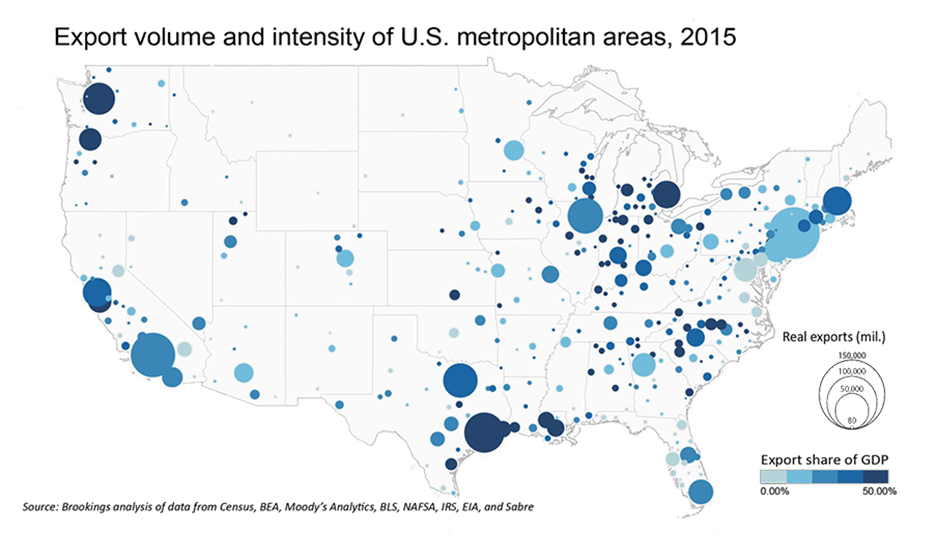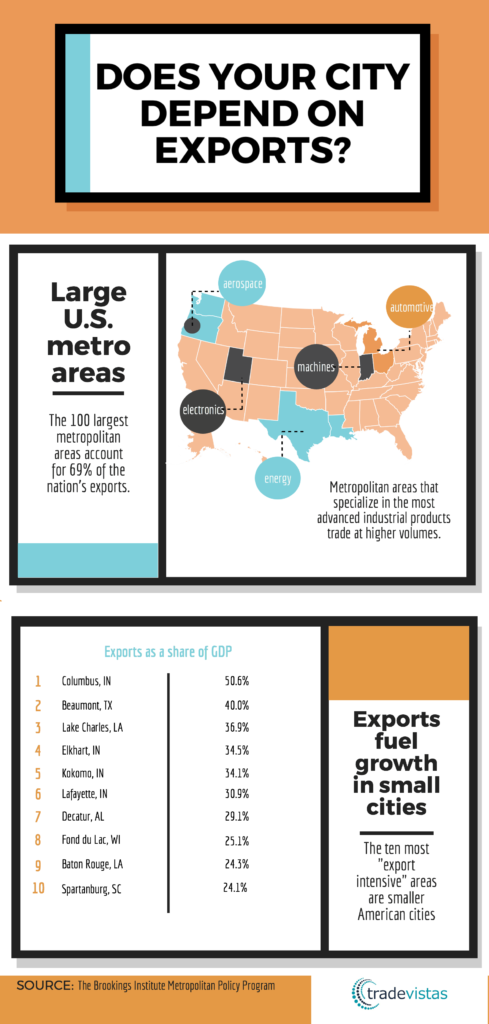Published 31 March 2017
If you were to take a guess as to which American metropolitan areas export the most, you’d probably be right: New York, Los Angeles, Houston, Chicago, Dallas, and Seattle top the list.
Bigger metropolitan areas export higher volumes
If you were to take a guess as to which American metropolitan areas export the most, you’d probably be right: New York, Los Angeles, Houston, Chicago, Dallas, and Seattle top the list. Each region sells more than $50 billion every year to overseas customers. Together, the residents of these five metropolises account for a quarter of the nation’s total exports.
Ranking #1 out of 381 metropolitan areas, New York-New Jersey-Pennsylvania exported $126.5 billion in 2015. Despite exporting such a significant volume, the area is #247 out of 381 in terms of export dependence. Like its peers, this metropolitan area has an economy that is so large and diverse, it relies on exports to drive just nine percent of its GDP.
Smaller metropolitan areas tend to be more export “intense”
In comparison, the economies of many smaller American cities center on the productivity of a handful of industries or companies. Those that depend on energy or that are home to advanced manufacturers, often rely more heavily on exports to drive growth in the local economy. In the map below, the more “export intensive,” the darker the blue.

When ranked not by sheer value of exports, but by exports as a share of local GDP, it’s America’s smaller cities that top the list – four of the most export dependent are smaller cities in Indiana. They are production centers in the Midwest and South, and oil and chemical exporters in Texas and Louisiana.

Advanced industrial centers depend heavily on exports to drive the local economy and employ people
The Brookings Institute Metropolitan Policy Program, which produced the data set, points out that the most export-dependent economies tend to be major centers of advanced industries.
Manufacturing clusters can be found Wichita and Seattle, which specializes in aerospace, Detroit and Youngstown which have a longstanding advantage in automotive, Portland and Ogden, Utah which are home to the electronics industry, and of course the energy towns of Baton Rouge and Houston. These are globally competitive centers for R&D and production in their industries. Exports account for at least 15 percent of GDP, supporting not just the local economy but also the tens of thousands of jobs connected to those industries.
Measuring where the value is created, not simply where it’s exported
The Brookings data derives estimates that are based on where goods or services are produced, not the location where it was exported. That’s an important contribution because it gives us a truer picture of the role of exports in specific localities and the value of exports in economic recovery, growth, and employment comparatively among American metropolitan areas. What the data also show is that American cities are the leading the underlying shift towards economic growth through services exports.
Beneath the national debate are cities large and small with trade profiles that might just surprise you. Curious about how much your city exports? Explore the data at Brookings.
Share this graphic:
https://magic.piktochart.com/output/21047470-metropolitan-traders
© The Hinrich Foundation. See our website Terms and conditions for our copyright and reprint policy. All statements of fact and the views, conclusions and recommendations expressed in this publication are the sole responsibility of the author(s).


